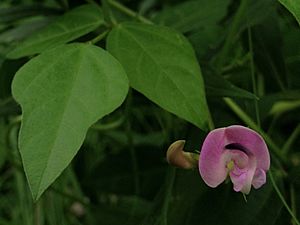Amberique-bean facts for kids
Quick facts for kids Amberique-bean |
|
|---|---|
 |
|
| Conservation status | |
| Scientific classification | |
| Genus: |
Strophostyles
|
| Species: |
helvola
|
| Synonyms | |
|
|
Strophostyles helvola, also known as the amberique-bean, annual sand bean, or trailing fuzzybean, is a type of flowering plant. It belongs to the legume family, which includes beans and peas. This plant grows naturally in eastern Canada and the eastern United States.
Contents
About the Amberique-Bean
This plant is a vine that can grow up to 3 meters (about 10 feet) long. It can live for one year (annual) or many years (perennial). Its stems, leaves, and pods are slightly fuzzy.
Leaves and Flowers
The leaves have three parts, often shaped like a fiddle. The flowers look like peas and are pink-purple, but they fade to a creamy yellow color. A special part of the flower, called the keel petal, curves in a unique way. This curving keel petal helps scientists tell this plant apart from others in its group.
Fruit and Seeds
The fruit of the amberique-bean is a pod, up to 10 centimeters (about 4 inches) long. Inside, there are shiny black seeds. These seeds have tiny hairs on them from the inside of the pod. These hairs help the seeds float in water. This floating ability is thought to have helped the plant spread along rivers and other waterways.
Scientists mainly identify Strophostyles helvola by its special keel petal. They also look at its long, round pods and its often lobed (divided) leaves. However, another similar plant, Strophostyles umbellata, can also have lobed leaves.
Plant Names and Types
Sometimes, you might see this plant called Strophostyles helvula. This is a common way to spell its name, but Strophostyles helvola is the official scientific name. Scientists have also identified a slightly different type of this plant, called S. helvola var. missouriensis. However, there isn't much strong evidence to show that these different types are truly distinct.
Why This Plant is Important
Strophostyles helvola is a wild relative of the common bean (Phaseolus vulgaris) that people grow and eat. Because of this, it can help scientists learn how bean plants adapt to tough environments. For example, some of these plants that grow near the coast can handle salty conditions very well. This is because certain genes in these plants work harder to help them survive in salty soil. Studying them could help us grow beans in more places.
Where It Grows and How It Helps Nature
This bean plant can grow in many different places, even in areas that have been disturbed. It's known as a pioneer species, meaning it's one of the first plants to grow in new or damaged areas where few other plants can survive. It can grow in various types of soil, especially sandy ones, and can handle both dry and moist conditions.
You can often find it growing in dune habitats near the sea. Here, tiny fungi called arbuscular mycorrhizae help the plant deal with the salty conditions. These fungi live on the plant's roots and help it take in water and nutrients.
How People Have Used This Plant
Long ago, Native American peoples used this plant for both medicine and food.
- The Houma people used it to help treat typhoid.
- The Iroquois used it on their skin to soothe poison ivy rashes and treat warts.
- The Choctaw people would boil and mash the roots to eat them.
Scientists have found many Strophostyles helvola seeds at old archaeological sites. This suggests that people might have used them like common beans in the past. Even though these seeds are smaller than cultivated beans, they have similar nutrients. The pods of this plant are still used today as a cooked vegetable in some parts of South Central Mindanao, Philippines.




